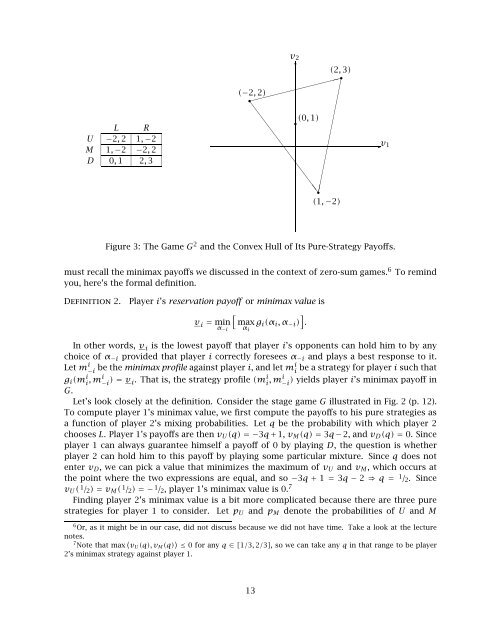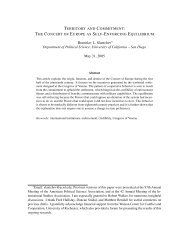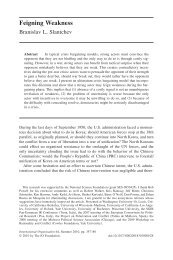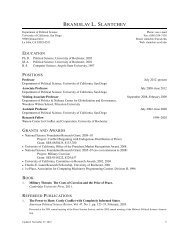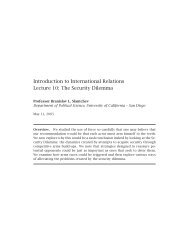Game Theory: Repeated Games - Branislav L. Slantchev (UCSD)
Game Theory: Repeated Games - Branislav L. Slantchev (UCSD)
Game Theory: Repeated Games - Branislav L. Slantchev (UCSD)
You also want an ePaper? Increase the reach of your titles
YUMPU automatically turns print PDFs into web optimized ePapers that Google loves.
L R<br />
U −2, 2 1, −2<br />
M 1, −2 −2, 2<br />
D 0, 1 2, 3<br />
v2<br />
✻<br />
(2, 3)<br />
<br />
(−2, 2)<br />
✘ ❙<br />
❙❙❙❙❙❙❙❙❙❙❙<br />
<br />
(0, 1)<br />
<br />
(1, −2)<br />
✘✘✘✘✘✘ ✘✘✘✘✘ ☎<br />
☎<br />
☎<br />
☎<br />
☎<br />
☎<br />
☎<br />
☎<br />
☎<br />
☎<br />
☎<br />
☎<br />
☎<br />
☎<br />
✲v1<br />
Figure 3: The <strong>Game</strong> G 2 and the Convex Hull of Its Pure-Strategy Payoffs.<br />
must recall the minimax payoffs we discussed in the context of zero-sum games. 6 To remind<br />
you, here’s the formal definition.<br />
Definition 2. Player i’s reservation payoff or minimax value is<br />
<br />
<br />
vi = min<br />
α−i max gi(αi,α−i)<br />
αi .<br />
In other words, vi is the lowest payoff that player i’s opponents can hold him to by any<br />
choice of α−i provided that player i correctly foresees α−i and plays a best response to it.<br />
Let m i<br />
−i be the minimax profile against player i, andletmi i be a strategy for player i such that<br />
gi(m i<br />
i ,mi −i ) = vi. That is, the strategy profile (m i<br />
i ,mi −i ) yields player i’s minimax payoff in<br />
G.<br />
Let’s look closely at the definition. Consider the stage game G illustrated in Fig. 2 (p. 12).<br />
To compute player 1’s minimax value, we first compute the payoffs to his pure strategies as<br />
a function of player 2’s mixing probabilities. Let q be the probability with which player 2<br />
chooses L. Player 1’s payoffs are then vU(q) =−3q +1, vM(q) = 3q −2, and vD(q) = 0. Since<br />
player 1 can always guarantee himself a payoff of 0 by playing D, the question is whether<br />
player 2 can hold him to this payoff by playing some particular mixture. Since q does not<br />
enter vD, we can pick a value that minimizes the maximum of vU and vM, which occurs at<br />
the point where the two expressions are equal, and so −3q + 1 = 3q − 2 ⇒ q = 1 /2. Since<br />
vU( 1 /2) = vM( 1 /2) =−1 /2, player 1’s minimax value is 0. 7<br />
Finding player 2’s minimax value is a bit more complicated because there are three pure<br />
strategies for player 1 to consider. Let pU and pM denote the probabilities of U and M<br />
6Or, as it might be in our case, did not discuss because we did not have time. Take a look at the lecture<br />
notes.<br />
<br />
7Note that max vU (q), vM(q) ≤ 0foranyq∈ [1/3, 2/3], so we can take any q in that range to be player<br />
2’s minimax strategy against player 1.<br />
13


